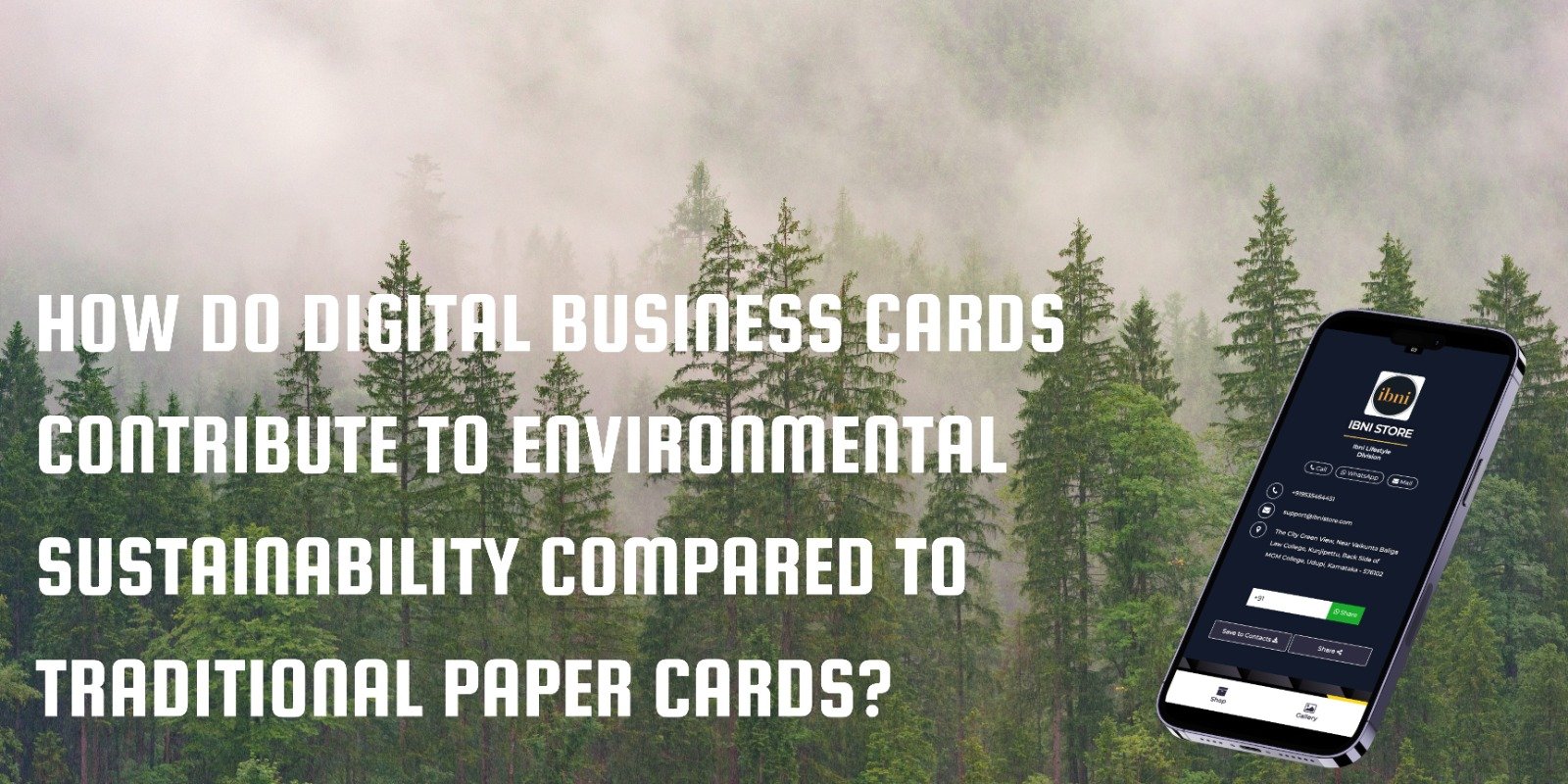Introduction:
In the world of networking and professional introductions, business cards have long been the tangible representation of connections made. Yet, as we become more attuned to the environmental consequences of our actions, it becomes evident that even the seemingly innocuous act of exchanging paper business cards has implications that stretch far beyond the initial interaction. This article delves into the intricate ways in which digital business cards contribute to environmental sustainability in stark comparison to their traditional paper counterparts.
As we explore the various dimensions of this comparison, it becomes clear that the benefits of adopting digital business cards extend well beyond convenience and efficiency. The shift signifies a commitment to conservation, a reimagining of networking practices, and an embrace of technological solutions that align with a greener future. Join us on this journey as we uncover the layers of impact that digital business cards bring to the forefront of the sustainability discourse, offering insights into how these choices, no matter how small, can collectively contribute to more harmonious coexistence with our planet.
Environmental Impact of Traditional Paper Business Cards:
Traditional paper business cards have long been a staple in professional networking, serving as a tangible representation of one’s identity and affiliations. However, beneath their seemingly innocuous presence lies a trail of environmental consequences that are increasingly hard to ignore. Understanding the environmental impact of paper business cards is essential to appreciating the strides made by their digital counterparts toward sustainability.
1. Resource Depletion and Deforestation:
The production of paper business cards requires significant amounts of natural resources, most notably wood pulp derived from trees. This demand for timber contributes to deforestation, a process that not only disrupts ecosystems but also eliminates carbon-absorbing trees. Consequently, the loss of forests reduces the planet’s capacity to mitigate climate change, making the adoption of digital alternatives a logical step toward preserving these vital ecosystems.
2. Energy Consumption and Carbon Emissions:
The life cycle of a paper business card involves multiple energy-intensive stages, from tree harvesting to paper processing, printing, and transportation. Each step contributes to carbon emissions, a major driver of global warming. The manufacturing processes alone account for a substantial carbon footprint. In contrast, digital business cards circumvent energy-intensive paper production and significantly reduce carbon emissions by using electronic devices for storage and sharing.
3. Waste Generation and Landfill Impact:
The short lifespan of paper business cards often leads to their frequent disposal, resulting in accumulated waste. The disposal process adds to landfill loads, contributing to the degradation of land and potential pollution. Furthermore, the ink and chemicals used in printing paper cards can leach into the environment, affecting soil and water quality. Digital cards eliminate the need for disposal, offering a sustainable alternative that minimizes waste generation.
4. Water Consumption and Pollution:
The paper production process necessitates substantial amounts of water for pulp creation, bleaching, and finishing. This water consumption contributes to resource depletion and can lead to water pollution due to the release of chemicals into water bodies. By adopting digital business cards, individuals and businesses can contribute to water conservation and the reduction of chemical pollution.
5. Transportation Impact:
The distribution of paper business cards involves transportation, which consumes energy and emits greenhouse gases. International shipping and air travel further exacerbate the carbon footprint associated with paper cards. On the other hand, digital business cards are shared electronically, eliminating the need for physical transportation and thereby reducing emissions.
6. Limited Longevity and Updates:
Traditional paper business cards have a finite lifespan, often requiring frequent reprints due to changes in contact information or design updates. Each reprint contributes to additional resource consumption, waste, and emissions. Digital business cards, however, can be easily updated without the need for reprints, making them a more sustainable and adaptable choice over time.
In conclusion, traditional paper business cards, while a long-standing tradition in networking, come with a host of environmental drawbacks that align poorly with today’s sustainability imperatives. The adoption of digital business cards offers a compelling solution, addressing resource depletion, carbon emissions, waste generation, and other environmental concerns. As we continue to redefine our practices in alignment with a greener future, embracing digital business cards represents a conscientious step towards a more sustainable and ecologically aware professional landscape.
Environmental Impact of Traditional Paper Business Cards:
Traditional paper business cards have long been a staple in professional networking, serving as a tangible representation of one’s identity and affiliations. However, beneath their seemingly innocuous presence lies a trail of environmental consequences that are increasingly hard to ignore. Understanding the environmental impact of paper business cards is essential to appreciating the strides made by their digital counterparts toward sustainability.
1. Resource Depletion and Deforestation:
The production of paper business cards requires significant amounts of natural resources, most notably wood pulp derived from trees. This demand for timber contributes to deforestation, a process that not only disrupts ecosystems but also eliminates carbon-absorbing trees. Consequently, the loss of forests reduces the planet’s capacity to mitigate climate change, making the adoption of digital alternatives a logical step toward preserving these vital ecosystems.
2. Energy Consumption and Carbon Emissions:
The life cycle of a paper business card involves multiple energy-intensive stages, from tree harvesting to paper processing, printing, and transportation. Each step contributes to carbon emissions, a major driver of global warming. The manufacturing processes alone account for a substantial carbon footprint. In contrast, digital business cards circumvent energy-intensive paper production and significantly reduce carbon emissions by using electronic devices for storage and sharing.
3. Waste Generation and Landfill Impact:
The short lifespan of paper business cards often leads to their frequent disposal, resulting in accumulated waste. The disposal process adds to landfill loads, contributing to the degradation of land and potential pollution. Furthermore, the ink and chemicals used in printing paper cards can leach into the environment, affecting soil and water quality. Digital cards eliminate the need for disposal, offering a sustainable alternative that minimizes waste generation.
4. Water Consumption and Pollution:
The paper production process necessitates substantial amounts of water for pulp creation, bleaching, and finishing. This water consumption contributes to resource depletion and can lead to water pollution due to the release of chemicals into water bodies. By adopting digital business cards, individuals and businesses can contribute to water conservation and the reduction of chemical pollution.
5. Transportation Impact:
The distribution of paper business cards involves transportation, which consumes energy and emits greenhouse gases. International shipping and air travel further exacerbate the carbon footprint associated with paper cards. On the other hand, digital business cards are shared electronically, eliminating the need for physical transportation and thereby reducing emissions.
6. Limited Longevity and Updates:
Traditional paper business cards have a finite lifespan, often requiring frequent reprints due to changes in contact information or design updates. Each reprint contributes to additional resource consumption, waste, and emissions. Digital business cards, however, can be easily updated without the need for reprints, making them a more sustainable and adaptable choice over time.
Conclusion:
In the intricate tapestry of environmental sustainability, the transition from traditional paper business cards to digital alternatives emerges as a noteworthy thread, weaving together innovation, conservation, and conscious choices. As we conclude this exploration of how digital business cards outshine their paper counterparts in terms of environmental impact, it’s evident that the advantages extend far beyond the realms of technological convenience.
The stark reduction in resource consumption achieved by eliminating the need for paper production is one of the cornerstones of this shift. By eschewing deforestation and the extensive energy and water requirements inherent in paper manufacturing, digital business cards stand as an emblem of conservation, silently contributing to the preservation of vital ecosystems and biodiversity.
FAQ
Q1: How do digital cards reduce chemical pollution?
Traditional paper card production involves chemical-intensive processes like bleaching and colouring, which can pollute water and soil. Digital cards eliminate the need for these processes, resulting in reduced chemical pollution.
Q2: What’s the energy efficiency of digital business cards?
Digital cards consume minimal energy for creation, distribution, and sharing compared to the energy-intensive processes of paper card production. This efficiency contributes to lower carbon emissions.
Q3: Are digital business cards accessible over time?
Yes, digital cards can be stored and accessed indefinitely, reducing the need for frequent reprints and updates that contribute to paper waste generation.
Q4: How do digital cards impact global reach and cultural shifts?
Digital cards can be shared instantly across the globe, reducing emissions from international shipping. Their adoption reflects a cultural shift towards sustainable practices and raises awareness about environmental impact.
Q5: What’s the overall benefit of choosing digital business cards for environmental sustainability?
Opting for digital business cards aligns with a more eco-conscious approach to networking and communication. It contributes to deforestation reduction, carbon emissions mitigation, water conservation, waste reduction, and a broader cultural awareness of sustainability.
Embracing digital business cards isn’t just about embracing technology; it’s about embracing a more environmentally responsible way of conducting business and making connections. By making this shift, individuals and businesses play a role in fostering a greener future for generations to come.

